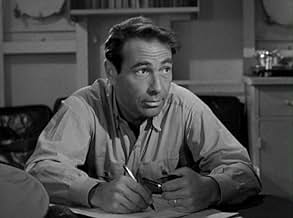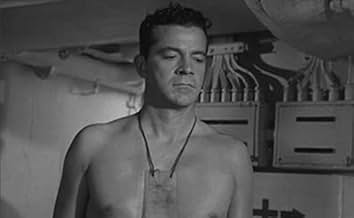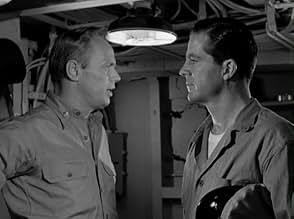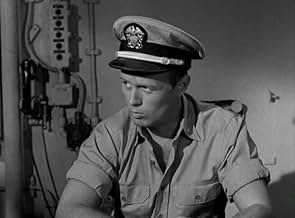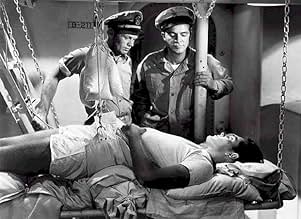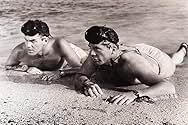Ajouter une intrigue dans votre langueThe new commander of a Navy Underwater Demolition Team--nicknamed "Frogmen"--must earn the respect of the men in his unit, who are still grieving over the death of their former commander and... Tout lireThe new commander of a Navy Underwater Demolition Team--nicknamed "Frogmen"--must earn the respect of the men in his unit, who are still grieving over the death of their former commander and resentful of the new one.The new commander of a Navy Underwater Demolition Team--nicknamed "Frogmen"--must earn the respect of the men in his unit, who are still grieving over the death of their former commander and resentful of the new one.
- Réalisation
- Scénario
- Casting principal
- Nommé pour 2 Oscars
- 1 victoire et 3 nominations au total
- Chief Ryan
- (non crédité)
- Dr. Ullman
- (non crédité)
- Ferrino
- (non crédité)
- Crew Member
- (non crédité)
- Crew Officer
- (non crédité)
- Kinsella
- (non crédité)
- Chief Petty Officer Lane
- (non crédité)
- Gunner
- (non crédité)
Avis à la une
The acting is outstanding and very real, especially to be so good that an old man like myself, remembers how I felt all the times I saw the film. If a film and the men involved in telling the tale of "The Frogmen" left that much impression and remembered to this day, then it had to be great acting, direction and favorably produced. There was no outlandish computer graphic techniques of today nor scenes of blowing up the world that come so common place in todays action genra films, but a reason and purpose for the gritty life and death struggle each man faced to become a frogman in the U. S. Navy or UDT (Underwater Demolition Teams) as they were and are called.
This black and white picture was dominated by the snarling Richard Widmark in perhaps his best performance in his career. I know many remember him for other films, but to me, he made this film and was the quintessential commander training his men to do a very difficult job with nothing more than shear strength of character and leadership. They did not have the high tech apparatus of todays Seals, but for what they lacked in equipment they more than made up for in "guts and glory" beneath the waters.
The rest of the cast, Dana Andrews, Gary Merrill, Jeffrey Hunter and Robert Wagner, just to name a few seemed to be portraying what is best in the Navy and men of war. Several more gave memorable performances in telling the tale of "The Frogmen" and the U. S. Navy's dedication to the finest in warfare.
The standard war movie is one thing, but this is a classic not seen much today and one in which many that followed learned by this tale of the U. S. Navy.
However, the project was obviously a heart-felt effort to capture, in detail, life aboard a WWII vessel, the procedures, the politics, and the rather fascinating methods and exploits of early UDTs, and that's what makes the film stand out. What you get is (I'm guessing) a pretty accurate representation of naval special forces in WWII, and it is quite interesting to watch how a team would covertly get in and out of shallow water near a beach to plant explosives and do recon, while being heavily shelled, often with nothing on them besides swim trunks, flippers and goggles! There are also a few very good, tense scenes. (the scene where their explosives expert has to disarm a torpedo with a tongue depressor is particularly nice-- expresses all the emotion and tension of such a moment without forcing it with a dramatic score).
Recommended to anyone interested in war history, or who enjoys a nicely crafted war movie.
He also used to to tell stories about Dana Andrews and his drinking during the filming, but that is another story. It is a good movie and, from Dad's and the UDT's perspective, had some BS in it - but relatively accurate overall.
In Korea, his team was assigned to swim in from off-shore and go inland to blow up installations, bridges, etc. overrun by the North Koreans/Chinese. They had to swim their stuff in from miles offshore, hump the explosives inland (armed with a knife and a pistol - Dad said he used a .38 because he couldn't hit much of anything over 30 yards away with a .45), blow up the objective then make it back out. Of course, things were even MORE primitive for the combat swimmers of WWII!
The support cast is reliable - even talented. Unavoidably for the genre, we have the guy from Brooklyn - in this case Canarsie - played believably for a change by Harvey Lembeck. Not once did I hear him say the word "goil". Dana Andrews plays a veteran CPO who identifies too well with his crew and resents the skipper. Gary Merrill does a very credible job as the captain of the transport ship that delivers the UDT crew to their targets.
A couple of things caught my attention. Although this movie was produced in 1951, it depicts what amounts to an experimental unit developed in WW2. I couldn't help but notice how primitive the operations were back then. No underwater breathing gear, no communications once they were in the water, simple slates and pencils to record the details of their mission. As a launch brought them into target range, they would jump into a rubber boat, then roll off into the water. Worse yet, at their pick up point, they had to tread water, raise their hand, and wait like sitting ducks to be pulled back into the rubber boat at speed.
This is not a silly movie. It celebrates the courage of men doing a very dangerous job under impossible conditions. There are a few clichés here, but nothing we can't overlook. A good action adventure flick, well worth watching.
Le saviez-vous
- AnecdotesThe Underwater Demolition Team, the frogmen in the film, belong to is UDT-4 (some members of the team wear utility jackets with artwork of a large number "4" and a shark on the back). The real UDT-4 in World War II saw combat in the invasions of Okinawa, Saipan, Guam, and the Philippines. Like the fictional team in the film, the UDT-4 had one of their boats hit and sunk by Japanese fire at Leyte, and left a sign on the beach at Guam to welcome the invading Marines.
- GaffesThe triple-tank aqualungs used by the UDT frogmen during the film's climactic mission are incorrect for the WWII period. Although 'Jacques Cousteau', an officer in the French Navy, was working with experimental aqualungs near the end of WWII, U.S. Navy Underwater Demolition Teams did not have them during the war. Re-breathers, which had filters to trap carbon dioxide, were in use during this time period. Modern SEAL type units still use re-breathers because they produce no bubbles which can attract unwanted attention like they did in the movie. The Japanese divers in the movie had bubble-less re-breathers.
- Citations
Lt. Cmdr. Pete Vincent: Looks like you've got what amounts to a legal mutiny on your hands.
- ConnexionsReferenced in Junior (1985)
Meilleurs choix
- How long is The Frogmen?Alimenté par Alexa
Détails
- Durée1 heure 36 minutes
- Couleur
- Rapport de forme
- 1.37 : 1
Contribuer à cette page



